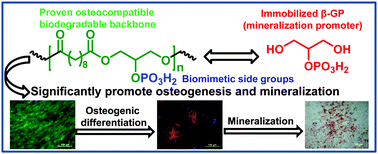Phosphorylated poly(sebacoyl diglyceride) – a phosphate functionalized biodegradable polymer for bone tissue engineering
Abstract
Phosphorylated polymers are promising for bone regeneration because they may recapitulate the essence of the phosphorylated bone extracellular matrix (ECM) to build an instructive environment for bone formation. However, most of the existing synthetic phosphorylated polymers are not fully biodegradable; thus, they are not ideal for tissue engineering. Here, we designed and synthesized a new phosphorylated polymer, poly(sebacoyl diglyceride) phosphate (PSeD-P), based on the biodegradable osteoconductive backbone PSeD. To our knowledge, PSeD-P is the first polymer to integrate the osteoinductive moiety β-glycerol phosphate (β-GP). PSeD-P shows good biodegradability and can be readily fabricated on 3D porous scaffolds. It has a porous structure with interconnected macropores (75–150 μm) and extensive micropores (several microns). PSeD-P promotes the adhesion, proliferation, and maturation of osteoblasts more effectively than poly(lactic-co-glycolic acid) (PLGA). Furthermore, PSeD-P induces a significantly higher expression of osteogenic biomarkers and ALP activity in mesenchymal stem cells (MSCs) compared to its non-phosphorylated precursor, PSeD. The level of improvement is comparable to free β-GP in culture medium. More importantly, without using β-GP, the typical mineralization promoter in osteogenic culture media, PSeD-P substantially induces the mineralization of the ECM in MSCs, which is totally absent using PSeD under identical culture conditions. PSeD-P provides a new strategy to integrate bioactive phosphates via β-GP into biomaterial, and has promise for bone regeneration applications. In addition, the synthetic method is versatile; both the backbone and the side phosphate groups could be readily tailored to generate a family of phosphorylated polymers for a wide range of biomedical applications.


 Please wait while we load your content...
Please wait while we load your content...